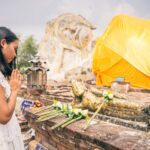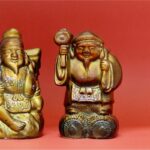Tea is more than just a hot beverage in Japan. It is part of a Japanese tea ceremony with a lot of cultural significance.
A tea ceremony takes a lot of planning. This is because such an essential ritual stands for peace, harmony, respect, and purity.
Discover additional information about the background of Japanese tea ceremony below.
Understanding the meaning of a Japanese Tea Ceremony
The notion of “Wabi” and “Sabi” is one of the most essential principles behind the Japanese tea ceremony. “Wabi” symbolizes calm, sober refinement and the spiritual experiences of human life. The word “Sabi,” which means weathered or decomposed, symbolizes the tangible part of life.
Being aware of this emptiness and imperfection is seen to be a crucial step toward spiritual enlightenment. You can get a peek into this fascinating aspect of Japanese culture by participating in a tea ceremony.
What happens during a tea ceremony?
The tea ceremony’s steps will vary depending on the season and setting. Typically, the host and visitor will exchange a silent bow. Next, they ritually cleanse their mouths with water and wash their hands. Afterward, they will remove their shoes and take their seats according to rank.
A multi-course meal will be served to the visitors, along with sake and a little dessert. There is a pause after the dinner when the visitors leave the room. The host cleans it up, arranges flowers, and gets ready to serve tea.
The visitors are invited back into the tea room, where they must again purify themselves before looking over the furnishings.
The tea scoop, whisk, and tea bowl are all ritually cleansed together with all other tools used during the ritual.
Following a bow exchange, the first visitor is offered a bowl of tea. They take a sip, and thank the host for the tea. Then, they bow, wipe the rim, and then hand it to the next visitor. Until everyone has sipped tea from the same bowl, the process is repeated.
What’s the history behind the Japanese Tea Ceremony?
When a Buddhist monk returned from China in the ninth century, he brought with him the tradition of the Japanese tea ceremony, which has ties to Buddhism.
The Emperor Saga was on a trip to Karasaki in the year 815, and according to the entry in the Nihon Koki, the Buddhist monk Eichu personally made and served sencha to him.
At the time tea became popular in Japan, it had already been well-known for more than a thousand years in China.
In China, green tea was primarily consumed for medicinal purposes, and Buddhist monasteries employed it in religious rites. It started to develop its own look and became a prestige symbol among the warrior class in Japan.
Where do Japanese Tea Ceremonies take place?
Japanese tea ceremonies are often held in rooms or venues that have been specifically built for the purpose. While a specially constructed tatami-floored room is regarded as the ideal setting for tea, any location where the tools needed for preparing and serving tea may be placed out and where the host can make tea in front of the seated guests can be employed. For instance, a tea party known as nodate can be hosted outdoors in a picnic-style setting.
A chashitsu is a specially constructed space created for the wabi style of tea. Low ceilings, a hearth that is incorporated into the floor, an alcove where scrolls can be hung and other ornamental items can be placed, and separate entrances for the host and guests are common features of specially constructed chashitsu. It also has a mizuya, an attached preparation space.
Standard rooms are 4.5 mats, however smaller and bigger rooms are frequently utilised. In wabi style tea rooms, the construction materials and décor are purposefully plain and unadorned. For tea, chashitsu can also refer to standalone structures. These buildings, often known as tea houses in English, may have a number of tea rooms of various sizes and types, waiting areas, dressing rooms, and other facilities, and they may be encircled by a roji, or tea garden.
The different ways of preparing Japanese tea
Matcha is typically prepared in one of two ways: thickly (koicha) or thinly (usucha), with thick tea using the highest-quality tea leaves. In the past, thin tea was made from the tea leaves used to load the koicha leaves in the tea urn. Tenmon-era Japanese historical texts on tea are the first to distinguish between usucha and koicha (1532–1555). The word “koicha” first appears in writing in 1575.
Koicha, as the name suggests, is a thick matcha beverage made with hot water that calls for around three times the amount of tea as usucha. Usucha is made by whisking hot water and matcha together with a tea whisk (chasen), while koicha is smoothed out by kneading a large quantity of powdered tea with the water.
One bowl of thin tea is shared by multiple people, whereas one bowl of thick tea is provided to each guest in their own separate bowl. This custom of sharing a bowl of koicha is thought to have originated with Sen no Riky and first appeared in written records in 1586.
The preparation and consumption of koicha, which is followed by usucha, are the two most significant aspects of a chaji. A chakai, which is the more laid-back, concluding part of a chaji, may merely entail the preparation and presentation of thin tea (and any additional confections).
The beautiful tradition of the Japanese Tea Ceremony
The ritualistic preparation and presentation of matcha, a powdered green tea, is known as the Japanese tea ceremony.
Although it is referred to as a “tea ceremony” in the West, in reality, it is rarely ceremonial. Tea is typically provided to family, friends, and associates; in western settings, the religious and ceremonial overtones are overemphasized.
Okakura Kakuz first used the term “Teaism” to refer to the distinctive worldview associated with the Japanese tea ritual rather than merely the ceremonial part, which is a viewpoint that many practitioners find objectionable.
- Writing & Understanding Haiku Poetry - May 25, 2023
- Shinkansen Bento: A Guide to the Delicious Train Station Box Lunches - May 25, 2023
- What is Takoyaki? - May 25, 2023







